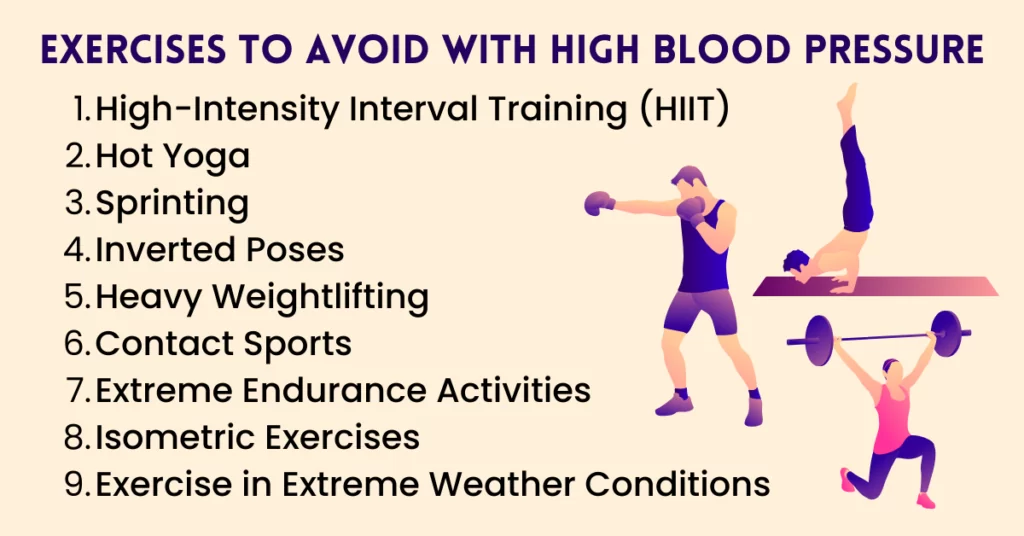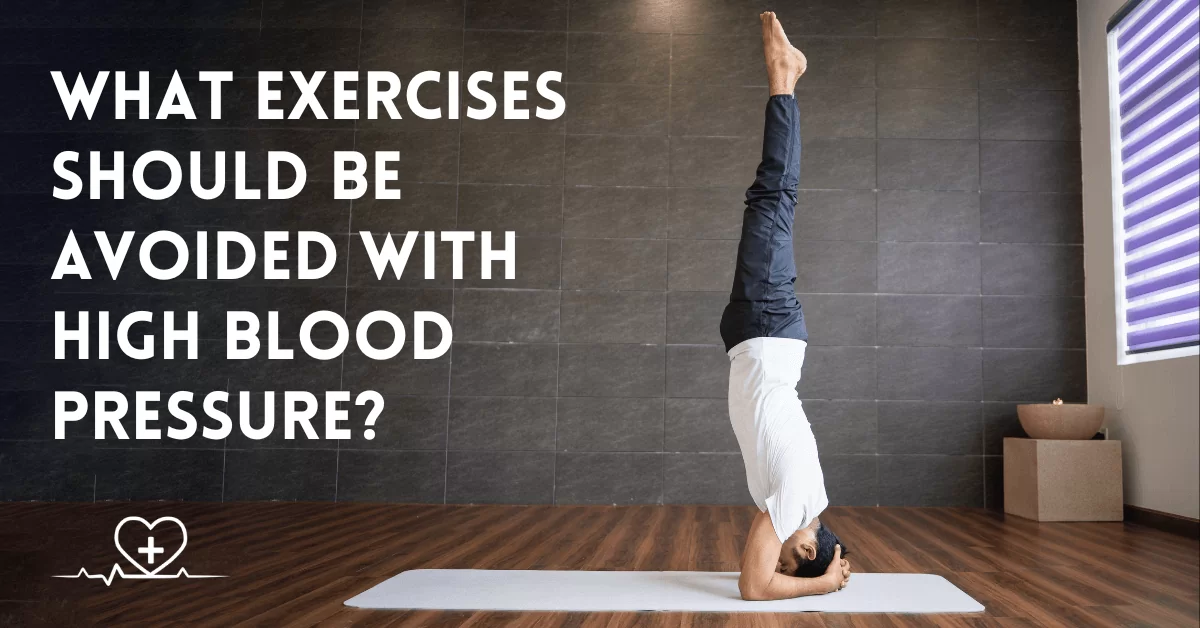Quick Answer: What Exercises Should Be Avoided with High Blood Pressure?
Individuals with high blood pressure should avoid exercises that significantly raise their blood pressure, such as heavy weightlifting, intense sprinting, or activities that involve straining and breath-holding. Instead, focus on low-to-moderate-intensity exercises like walking, swimming, or cycling, and consult a healthcare professional for personalized guidance.
Table of Contents
Introduction
High blood pressure, or hypertension, is a prevalent health concern affecting millions of people worldwide. It’s essential to manage this condition effectively, and one aspect of a healthy lifestyle is exercise. However, not all exercises are suitable for individuals with high blood pressure. In this article, we will explore the exercises that should be avoided to ensure your safety and well-being while staying physically active.
Exercises to Avoid

1. High-Intensity Interval Training (HIIT)
High-intensity interval Training, commonly known as HIIT, has gained popularity for its quick and efficient workout sessions. While it can be highly effective for some, it may not be the best choice for those with high blood pressure. HIIT involves short bursts of intense exercise followed by brief recovery periods. The rapid changes in heart rate can put excess strain on your cardiovascular system, potentially worsening your blood pressure.
2. Hot Yoga
Yoga is generally recommended for its relaxation and stress-reduction benefits. However, hot yoga, which is practiced in a heated room, can pose risks for individuals with high blood pressure. The combination of high temperatures and strenuous poses can lead to dehydration and increased blood pressure. It’s advisable to stick to traditional, non-heated yoga classes.
3. Sprinting
Sprinting is another high-intensity exercise that may not be suitable for those with hypertension. The sudden and intense bursts of speed can cause a rapid increase in heart rate and blood pressure. It’s best to opt for moderate-intensity cardio exercises like brisk walking or cycling, which are gentler on the cardiovascular system.
4. Inverted Poses
Exercises that involve being upside down, such as headstands and handstands, can be dangerous for individuals with high blood pressure. These positions can lead to a significant increase in blood pressure in the head and neck, potentially causing health issues. If you enjoy yoga, choose poses that keep your head above your heart.
5. Heavy Weightlifting
Weightlifting can be a fantastic way to build strength and muscle mass. However, lifting extremely heavy weights can lead to a sudden and substantial increase in blood pressure. This happens because lifting heavy weights requires a significant amount of effort and can cause the blood vessels to constrict, leading to a spike in blood pressure. To manage this risk, it’s advisable to avoid one-rep max lifts and focus on lighter weights with higher repetitions. This approach helps build strength without putting excessive strain on your cardiovascular system.
6. Contact Sports
Sports like boxing, wrestling, and certain martial arts involve intense physical contact and high levels of physical exertion. These activities can lead to sudden adrenaline surges, which can elevate blood pressure significantly. Additionally, the physical impact of these sports can be risky for individuals with hypertension, as it may lead to injury or further increases in blood pressure. It’s generally recommended to choose alternative, less physically intense sports or activities to avoid potential harm.
7. Extreme Endurance Activities
Engaging in extreme endurance activities, such as long-distance running or ultra-marathons, can be demanding on the cardiovascular system. Prolonged, intense exercise can lead to overexertion, dehydration, and a dangerous spike in blood pressure. While some individuals with high blood pressure may be able to participate in endurance activities with proper medical supervision, it’s crucial to approach these activities cautiously and consult with your healthcare provider beforehand.
8. Isometric Exercises
Isometric exercises involve static muscle contractions, where you push or pull against an immovable object or maintain a position without moving. These exercises can cause a rapid and significant increase in blood pressure. Activities like lifting heavy objects, planks, or even certain yoga poses that involve isometric contractions should be avoided or modified for individuals with high blood pressure. Instead, focus on dynamic, rhythmic movements that do not put excessive strain on the cardiovascular system.
9. Exercise in Extreme Weather Conditions
Exercising in extreme weather conditions, whether it’s extremely hot or cold, can also pose risks for individuals with high blood pressure. In hot weather, the body may struggle to cool down, leading to overheating and an increase in blood pressure. Cold weather can cause blood vessels to constrict, raising blood pressure as well. It’s important to choose comfortable temperature conditions for your workouts and stay well-hydrated to mitigate these risks.
Safe Alternatives
Now that we’ve discussed exercises to avoid let’s explore safe alternatives for individuals with high blood pressure:
1. Walking: Walking is one of the simplest and most accessible forms of exercise. It’s low-impact, meaning it doesn’t put excessive stress on your joints. Brisk walking, where you maintain a pace that slightly elevates your heart rate and causes you to break a sweat, is an excellent choice for managing high blood pressure. This activity not only helps improve cardiovascular health but also enhances circulation and reduces stress.
2. Swimming: Swimming offers a full-body workout without the impact on your joints that some land-based exercises can have. The water provides natural resistance, helping you build strength and improve cardiovascular fitness. Swimming also has the added benefit of promoting relaxation due to the soothing nature of being in the water.
3. Cycling: Whether you prefer a stationary bike at the gym or cycling outdoors, cycling is a low-impact exercise that can be tailored to your fitness level. It strengthens the leg muscles, improves endurance, and helps regulate blood pressure over time. As with any exercise, start at a comfortable pace and gradually increase the intensity.
4. Tai Chi: Tai Chi is a gentle and slow-moving martial art that combines deep breathing, relaxation, and flowing movements. It’s particularly beneficial for individuals with high blood pressure because it reduces stress and promotes a sense of calm. Tai Chi also enhances balance and flexibility, which are essential aspects of overall health.
5. Low-Intensity Strength Training: Building and maintaining muscle strength is important for everyone, including those with high blood pressure. Low-intensity strength training with resistance bands or light dumbbells allows you to work on muscle tone without straining your cardiovascular system. Focus on controlled movements and proper form to minimize any sudden increases in blood pressure.
6. Yoga: Yoga is a holistic practice that combines physical postures, breathing exercises, and meditation. While some yoga styles can be intense, gentle forms like Hatha or Restorative Yoga are well-suited for individuals with high blood pressure. These practices emphasize relaxation, stress reduction, and controlled breathing, all of which contribute to better blood pressure management.
7. Pilates: Pilates is an exercise system that focuses on core strength, flexibility, and body awareness. It’s low-impact and can be customized to your fitness level. Pilates improves posture, stability, and muscle tone without causing a significant increase in blood pressure. It’s particularly suitable for those looking to strengthen their core muscles.
8. Aerobic Dancing: If you enjoy dancing, low-impact aerobic dance classes like Zumba or dance fitness can provide an enjoyable way to stay active. These classes incorporate dance moves to upbeat music while keeping the impact on joints minimal. Aerobic dancing helps improve cardiovascular fitness and coordination.
9. Hiking: Hiking is an excellent way to engage with nature while getting exercise. The level of intensity can vary depending on the terrain you choose. Opt for moderate trails to enjoy the benefits of hiking without overexerting yourself. It’s essential to stay hydrated and take breaks as needed.
10. Rowing: Rowing machines offer a unique full-body workout that combines cardiovascular exercise with resistance training. Rowing can be particularly effective at lowering blood pressure while building strength. Pay attention to your technique to ensure a safe and effective workout.
Remember that consistency is key when it comes to managing high blood pressure through exercise. Start gradually, progress at your own pace, and consult with your healthcare provider before embarking on any new exercise program. They can provide personalized guidance and ensure that your chosen activities align with your specific health needs and goals. Staying active is an essential part of a healthy lifestyle, and with these exercise alternatives, you can work towards better blood pressure management while enjoying the many benefits of physical activity.
Also Read:
Three Easy Exercises to Lower Blood Pressure – Make Your Own
Yoga For High Blood Pressure: A Holistic Approach To Hypertension Management
Best Pranayama For High Blood Pressure
Conclusion
Incorporating exercise into your daily routine can be a valuable tool for managing high blood pressure. However, it’s essential to choose exercises that are safe and suitable for your condition. By avoiding high-intensity workouts and focusing on low-impact, cardiovascular activities, you can improve your overall health and well-being while keeping your blood pressure in check.
FAQs
-
Can exercise worsen high blood pressure?
Exercise, when done correctly, can help lower and manage high blood pressure. However, certain types of exercise, like high-intensity workouts, can potentially worsen it. It’s essential to choose the right exercises and monitor your blood pressure during exercise.
-
How often should I exercise to manage high blood pressure?
Aim for at least 150 minutes of moderate-intensity aerobic exercise or 75 minutes of vigorous-intensity exercise per week, spread throughout the week. This can help lower your blood pressure and improve your overall health.
-
Are there any warning signs during exercise for people with high blood pressure?
Yes, if you experience dizziness, shortness of breath, chest pain, or severe fatigue during exercise, stop immediately and seek medical attention. These could be signs of your blood pressure becoming dangerously high.
-
Can yoga be beneficial for high blood pressure?
Yes, yoga can be beneficial for high blood pressure when practiced safely. Choose gentle yoga styles, avoid hot yoga, and focus on relaxation, deep breathing, and stress reduction.
-
Should I consult a healthcare professional before starting an exercise routine for high blood pressure?
It’s advisable to consult your healthcare provider before starting any new exercise routine, especially if you have high blood pressure or other underlying health conditions. They can provide personalized recommendations based on your medical history.
-
How long does it take to see improvements in blood pressure through exercise?
Individual results may vary, but many people start to see improvements in their blood pressure within a few weeks to a few months of consistent exercise. However, it’s crucial to maintain a regular exercise routine for long-term benefits.
